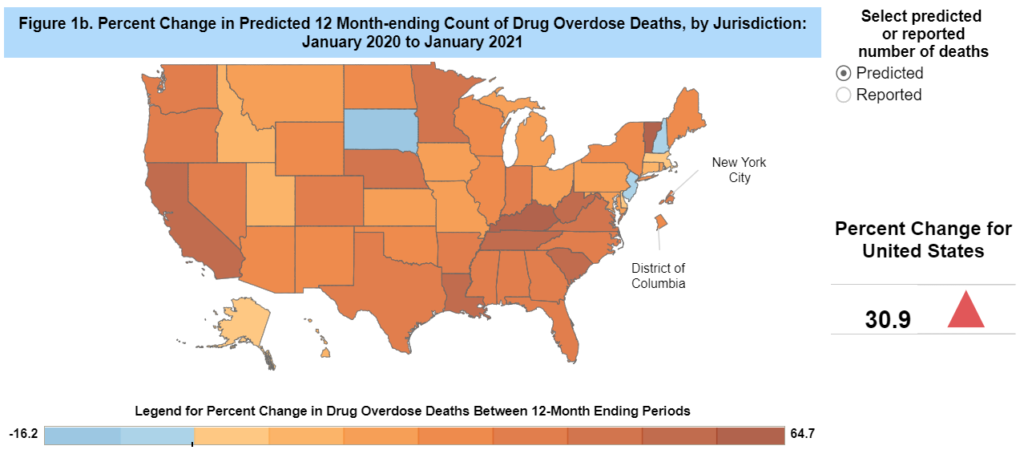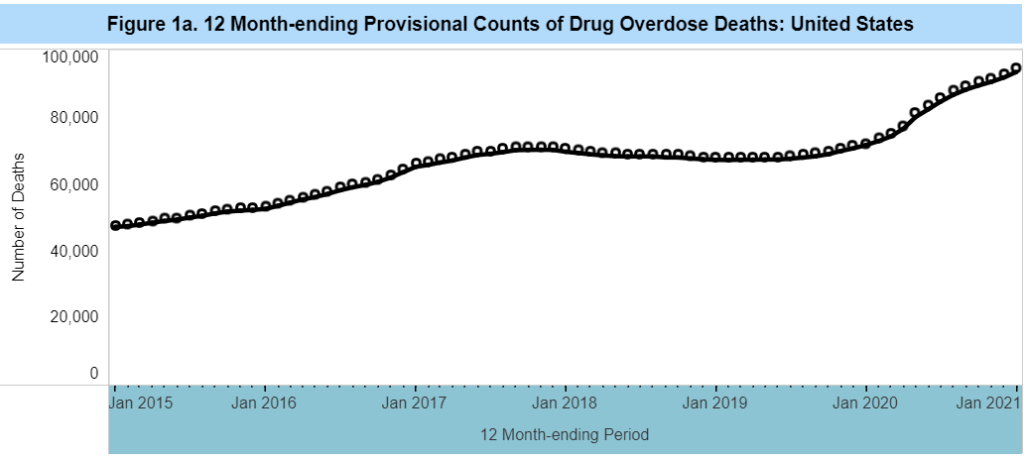
Drug Overdose Deaths: The Lethal Supply Behind A Worsening National Epidemic
By Deepti Govind
In July, the U.S. government reported that drug overdose deaths last year, in the midst of the Covid-19 pandemic, soared nearly 30% to a record number of around 93,000. That’s a massive spike from 2019’s 72,000 drug overdose deaths, provisional data for 2020 published by the Centers for Disease Control and Prevention (CDC) shows. The Substance Abuse and Mental Health Services Administration’s (SAMHSA) National Helpline corroborates that evidence. The helpline said it received 833,598 calls in 2020, a 27% increase from 2019.
Every state has reported a spike, or an increase, in overdose deaths or other problems during the pandemic, the American Medical Association (AMA) said in an issue brief published early August. All signs appear to be pointing to the fact that the country’s drug overdose epidemic is worsening.
There were fewer than 7,200 total U.S. overdose deaths reported in 1970, when a heroin epidemic was raging in U.S. cities, per the CDC, the Associated Press said. There were about 9,000 in 1988, around the height of the crack epidemic. In 2020, though, drug overdoses increased in all but two states: New Hampshire and South Dakota. Kentucky’s overdose count rose 54% in 2020. There were also large increases in South Carolina, West Virginia, and California. Vermont had the largest percentage jump — about 58% — which was smaller in terms of actual numbers.
To be sure, just last Thursday, local media reported that drug overdose and alcohol-related deaths reached all-time highs in 2020 in New Mexico, a state that already has a history of struggling with some of the highest nationwide death rates for these addictions. In New Mexico alone, more than 43,000 people have died from drugs and alcohol abuse over the past 30 years, a report presented to the Legislative Finance Committee showed, according to local media.
In Kentucky, it is younger people who are increasingly becoming part of the tragic statistic. The state’s overdose fatality report showed that young Kentuckians experienced the highest increase in drug overdose deaths last year, local media in that state reported. There was an overall increase in mortality, across age groups, but what’s particularly worrying is that the overall deaths nearly doubled (i.e., a 90% increase) when it comes to those aged 15-24.
Even in state prisons and jails, overdose is one cause of death that has spiked dramatically, NPR said, based on analysis of data published by the Bureau of Justice Statistics (BJS) in July. Given the lag in BJS data — its latest numbers only go up to 2018 — its likely that the trend may have continued well into 2020, during Covid-19.
Meanwhile in New Mexico, things appear to be only getting more aggravated with a rise in cases of overdoses from drugs like fentanyl and methamphetamine.

Poison In The Supply Chain
Fentanyl, in particular, is a dangerously powerful opioid that is sometimes misused by even mixing it with other drugs like heroin, methamphetamine, or cocaine to further increase its potency. It was developed to treat intense pain from ailments like cancer but is increasingly being sold illicitly. And it’s not just New Mexico that’s seeing a shift to drugs like fentanyl and methamphetamine. Across the country, prescription painkillers once drove the drug overdose epidemic. But they were soon replaced, first by heroin and then by fentanyl, and in some states methamphetamine too.
The Covid-19 pandemic worsened things by isolating those with drug addictions and by making treatment that much harder to get, with lockdowns and other restrictions in place through much of 2020. But, the real driving factor behind the surge is “an increasingly poisoned drug supply,” Shannon Monnat, an associate professor of sociology at Syracuse University who researches geographic patterns in overdoses told the Associated Press. “Nearly all of this increase is fentanyl contamination in some way. Heroin is contaminated. Cocaine is contaminated. Methamphetamine is contaminated,” Monnat added per the Associated Press article.
Even the AMA’s issue brief calls attention to the type of drugs in the supply chain. One prevailing theme is the fact that the epidemic now is driven by illicit fentanyl, fentanyl analogs, methamphetamine, and cocaine, often in combination or in adulterated forms, the AMA says. Overdoses related to prescription opioids and heroin remain high, with those drugs being increasingly adulterated with illicit fentanyl, it continues.
Added to the mix now is an increase in the supply of illicit benzodiazepine, a class of psychoactive drugs that are prescribed to treat conditions like anxiety, insomnia, and seizures. Benzodiazepine-involved overdose deaths had decreased during 2017–2019. But, from 2019 to 2020, benzodiazepine overdose visits per 100,000 emergency department visits increased (23.7%), both with (34.4%) and without (21.0%) opioid co-involvement, the CDC said in its Morbidity and Mortality Weekly Report last week.
Between April–June 2019 and April–June 2020, prescription and illicit benzodiazepine-involved overdose deaths increased 21.8% and 519.6%, respectively. During January–June 2020, 92.7% of benzodiazepine-involved deaths also involved opioids, and 66.7% involved illicitly manufactured fentanyls, the CDC adds.
With the proliferation of fentanyl, some experts do not expect any substantial decline in drug overdose deaths this year either, the Associated Press report says. National figures are not yet available for 2021, but there is data emerging from some states that seems to support this pessimism. Rhode Island, for example, reported 34 overdose deaths in January and 37 in February — the most for those months in the state in at least five years. According to the CDC, there were 72,124 number of reported drug overdose deaths nationwide in the 12 months ending in January 2020. Provisional data for a similar period ending January 2021 shows 94,134 reported deaths.
“Every overdose death is tragic. It’s tragic because it’s seemingly preventable. It’s tragic because it almost always takes someone who is too young to die,” Mike Abrams is president and CEO of the Ohio Hospital Association wrote in an opinion piece on USA Today. His brother, Randy Abrams, died of a fentanyl overdose in March 2019. Mike Abrams’ opinion piece comes in the run up to International Overdose Awareness Day, which happens to be on Tuesday, Aug. 31.

SAMHSA’s National Helpline: 1-800-662-HELP (4357) is a free, confidential, 24/7, 365-day-a-year treatment referral and information service (in English and Spanish) for individuals and families facing mental and/or substance use disorders.
You can also find additional resources on SAMHSA’s website here.